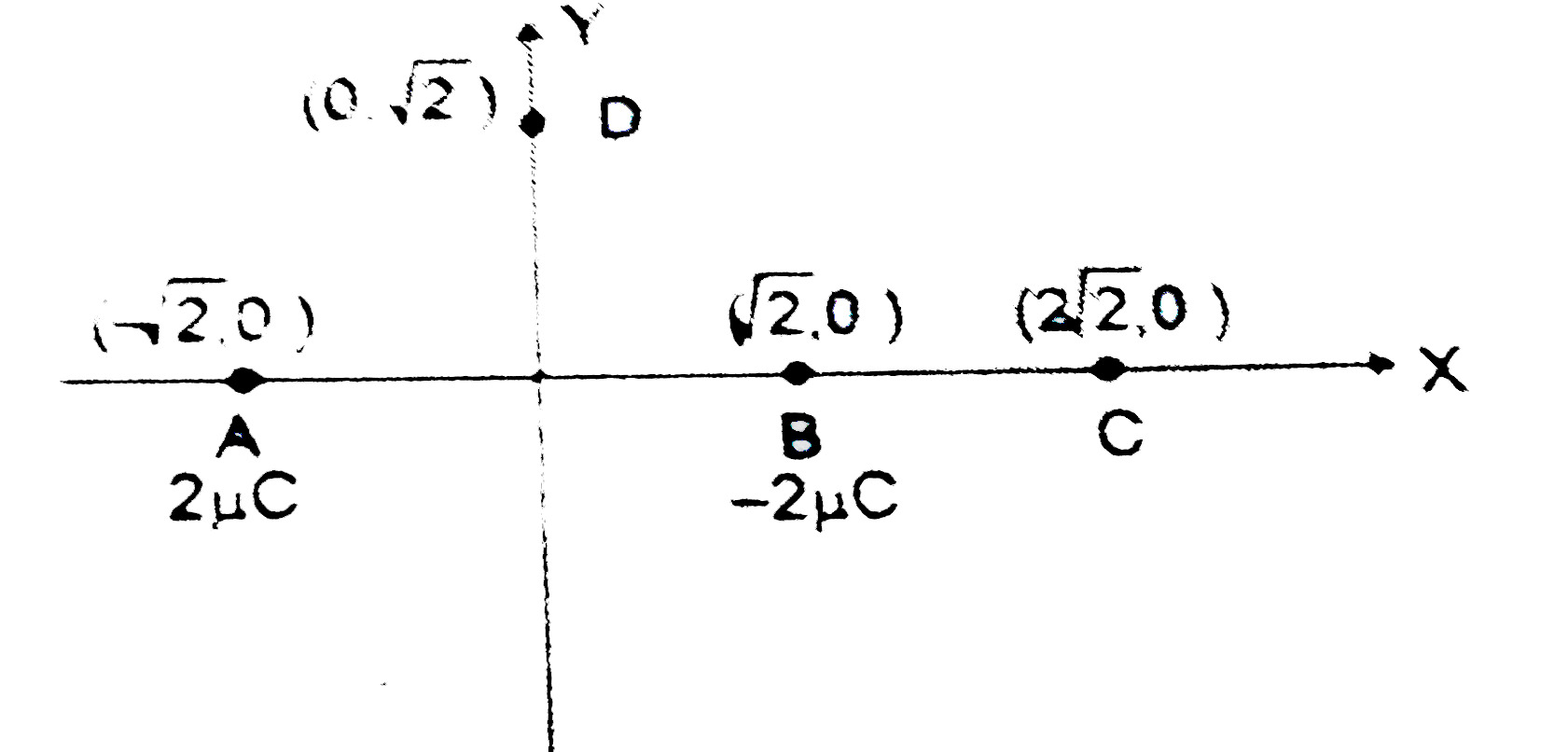Two charges of −4μCand+4μC are placed at the points A(1,0,4)andB(2,−1,5) location in an electric field →E=0.20ˆiV/cm. Calculate the torque acting on the dipole.
2.31×10−4N/m
1.13×10−4C/m
7.11×10−4C/m
7.04×10−4C/m
The correct Answer is:B
To calculate the torque acting on the dipole formed by two charges of −4μC and +4μC placed at points A(1,0,4) and B(2,−1,5) in an electric field →E=0.20^iV/cm, we can follow these steps:
Step 1: Calculate the distance vector →AB
The distance vector →AB can be calculated as:
→AB=→B−→A=(2,−1,5)−(1,0,4)=(2−1,−1−0,5−4)=(1,−1,1)
Step 2: Calculate the dipole moment →P
The dipole moment →P is given by:
→P=q⋅→d
where q=4μC=4×10−6C and →d=→AB. Therefore:
→P=4×10−6C⋅(1,−1,1)=(4×10−6,−4×10−6,4×10−6)C⋅m
Step 3: Convert the electric field to SI units
The electric field is given as:
→E=0.20^iV/cm=0.20×100^iV/m=20^iV/m
Step 4: Calculate the torque →τ
The torque →τ acting on the dipole in an electric field is given by:
→τ=→P×→E
Substituting the values we have:
→τ=(4×10−6,−4×10−6,4×10−6)×(20,0,0)
Step 5: Compute the cross product
Using the determinant method to calculate the cross product:
→τ=∣∣
∣
∣∣^i^j^k4×10−6−4×10−64×10−62000∣∣
∣
∣∣
Calculating this determinant:
→τ=^i((−4×10−6)⋅0−(4×10−6)⋅0)−^j((4×10−6)⋅0−(4×10−6)⋅20)+^k((4×10−6)⋅0−(−4×10−6)⋅20)
=0^i+80×10−6^j+80×10−6^k
Thus:
→τ=(0,80×10−6,80×10−6)N⋅m
Step 6: Calculate the magnitude of torque
The magnitude of torque is given by:
|→τ|=√(0)2+(80×10−6)2+(80×10−6)2=√2×(80×10−6)2=80×10−6√2≈1.13×10−4N⋅m
Final Answer
The torque acting on the dipole is approximately:
→τ≈1.13×10−4N⋅m
The distance vector →AB can be calculated as:
→AB=→B−→A=(2,−1,5)−(1,0,4)=(2−1,−1−0,5−4)=(1,−1,1)
The dipole moment →P is given by:
→P=q⋅→d
where q=4μC=4×10−6C and →d=→AB. Therefore:
→P=4×10−6C⋅(1,−1,1)=(4×10−6,−4×10−6,4×10−6)C⋅m
The electric field is given as:
→E=0.20^iV/cm=0.20×100^iV/m=20^iV/m
The torque →τ acting on the dipole in an electric field is given by:
→τ=→P×→E
Substituting the values we have:
→τ=(4×10−6,−4×10−6,4×10−6)×(20,0,0)
Using the determinant method to calculate the cross product:
→τ=∣∣
∣
∣∣^i^j^k4×10−6−4×10−64×10−62000∣∣
∣
∣∣
Calculating this determinant:
→τ=^i((−4×10−6)⋅0−(4×10−6)⋅0)−^j((4×10−6)⋅0−(4×10−6)⋅20)+^k((4×10−6)⋅0−(−4×10−6)⋅20)
=0^i+80×10−6^j+80×10−6^k
Thus:
→τ=(0,80×10−6,80×10−6)N⋅m
The magnitude of torque is given by:
|→τ|=√(0)2+(80×10−6)2+(80×10−6)2=√2×(80×10−6)2=80×10−6√2≈1.13×10−4N⋅m
The torque acting on the dipole is approximately:
→τ≈1.13×10−4N⋅m
Topper's Solved these Questions
- BOOK - DC PANDEY ENGLISHCHAPTER - ELECTROSTATICSEXERCISE - Assertion and Reason15videos
ELECTROSTATICS
- BOOK - DC PANDEY ENGLISHCHAPTER - ELECTROSTATICSEXERCISE - Match the columns5videos
ELECTROSTATICS
- BOOK - DC PANDEY ENGLISHCHAPTER - ELECTROSTATICSEXERCISE - Check point 1.520videos
ELECTROSTATICS
- BOOK - DC PANDEY ENGLISHCHAPTER - ELECTROSTATIC POTENTIAL AND CAPACITORSEXERCISE - (C) Chapter exercises50videos
ELECTROSTATIC POTENTIAL AND CAPACITORS
- BOOK - DC PANDEY ENGLISHCHAPTER - GRAVITATIONEXERCISE - All Questions135videos
GRAVITATION
Similar Questions
Two point charges 3μC and 2.5μC are placed at point A (1, 1, 2)m and B (0, 3, -1)m respectively. Find out electric field intensity at point C(3, 3, 3)m.
View SolutionTwo point charges 2μC and −2μC are placed at point A and B as shown in figure. Find out electric field intensity at points C and D. [All the distances are measured in meter].
 View Solution
View SolutionElectric dipole of moment →P=Pˆi is kept at a point (x, y) in an electric field →E=4xy2ˆi+4x2yˆj. Find the magnitude of force acting on the dipole.
View SolutionA magnet of magnetic moment 50ˆiA−m2 is placed along the x-axis in a magnetic field →B=(0.5ˆi+3.0ˆj)T. The torque acting on the magnet is
View SolutionAn electric dipole consists of two opposite charges of magnitude 1μC separated by a distance of 2cm.The dipole is placed in an electric filled 10−5Vm−1.The maximum torque that the field exert on the dipole is
View SolutionA surface element →ds=5ˆi is placed in an electric field →E=4ˆi+4ˆj+4ˆk. What is the electric flux emanting from the surface ?
View SolutionAs charge q=1μC is placed at point (1m,2m,4m). Find the electric field at point P(0,−4m,3m)
View SolutionTwo charges 10μCand−10μC are placed at points A.andB separated by a distance of 10 cm. Find the electric. field at a point P on the perpendicular bisector of AB at. a distance of 12 cm from its middle point.
View SolutionElectric charge of 1μC,−1μC and 2μC are placed in air at the corners A, B and C respectively of an equilateral triangle ABC having length of each side 10 cm. The resultant force on the charge at C is
View SolutionTwo particles A and B, having opposite charges2.0×10−6 and −2.0×10−6C , are placed at a separaton of 1.0 cm.(a) write down the electric dipole moment (b) Calculate the electric field at a point on the axis of the dipole 1.0 m away from the centre. (c ) Calculate the electric field at a point on the perpendicular bisector of the dipole and 1.0 m away from the centre.
View Solution

